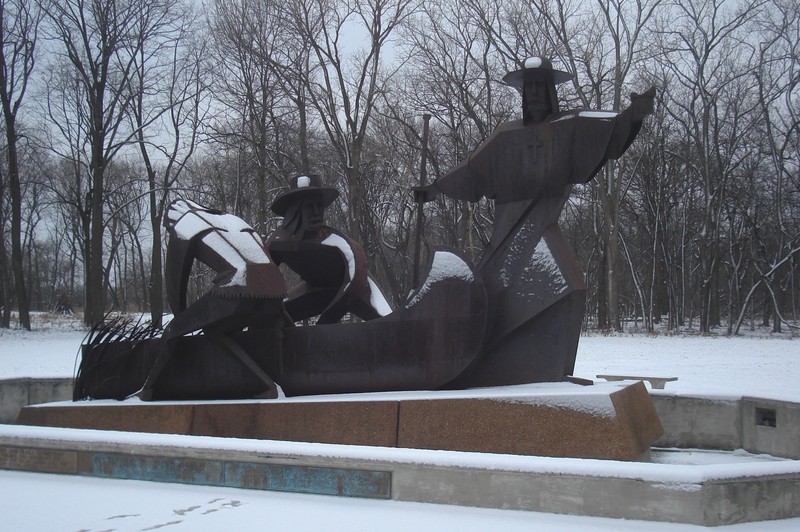Chicago Portage National Historic Site
Introduction
Text-to-speech Audio
Images

Backstory and Context
Text-to-speech Audio
The Chicago Portage is often referred to as Chicago's "Plymouth Rock" because it exists as the place where French explorers Père Jacque Marquette and Louis Jolliet (in 1673) met Native Americans and discovered the portage served as the connection between the Great Lakes and the Mississippi waterways. The discovery provided the realization that the Chicago region provided an easy connection between the Atlantic Ocean and the Gulf of Mexico through the Great Lakes. For a European and American society predicated on market economies, trade, and a need for navigation, the portage existed as potential profits whereas the Native Americans had used Chicago for far different needs. Today's Chicago represents what the portage meant to settlers, and how the area has changed since Europeans arrived to the region. 1
Upon discovering the portage, Jolliet suggested then a that a short canal cut through the portage area would create a vital transportation and trade connection.2 The realization of that vision manifested itself, much later, in the creation of the Illinois & Michigan Canal (I&M Canal), that was completed in 1848. The modern canal connected the Chicago River to the Illinois River, intrinsically connecting the East Coast to the Gulf of Mexico through Chicago.
Speculators and investors who gambled on Chicago's potential as a transportation hub also helped spur its potential as a railroad hub, which helped turn Chicago into a major city during the Industrial Revolution. To Wit: The portage showed Chicago had potential, and then humans invested in that potential, notably once marketplaces expanded in association with growing industry and transportation.3
A small portion of the historic connection between the Great Lakes and the Mississippi waterways, including a plaque, is preserved in the Forest Preserve District of Cook County’s Portage Woods and Ottawa Trail. It is one of only two National Historic Sites in Illinois and one of the few in the country that is not owned by the National Park Service.4 However, similar to many historical locations, the Portage Trail forged by Native Americans, and utilized by European trappers is completely paved over and old “Mud Lake," and now hosts the the world’s largest sewage treatment plant. As such, The Chicago Portage National Historic Site is the only major remnant of the European's discovery and settlement of Chicago and it is the only place where one can stand on the same ground walked upon by European explorers.5
The Friends of the Chicago Portage, a group dedicated to the sites preservation and history, notes, "You can stand on the footbridge over the short remnant of Portage Creek, stretch out your arms and know that Jolliet, Marquette, LaSalle, Tonti, Point du Sable, Kinzie, Hubbard, Ogden, and countless anonomous others from the discovery, exploration and creation of Chicago passed within an arm's length of you."
The site reminds one that Chicago, as an major urban center, did not emerge as a natural phenomenon. It was, for thousands and millions of years, a prairie, swamp, and natural source of drainage. Native Americans used the location for one purpose, but European settlers, and eventually residents of the United States, looked at the region much differently. For Europeans and Americans, Chicago existed as a prime area of real-estate that could be used to maximize navigation, transportation, and industrial needs - the type of needs associated with the free market. Over time, Chicago proved to be a major home to industry, and the home to many labor battles as workers and entrepreneurs collided. Jolliet could not have envisioned that Chicago would grow to host several millions of people or be where skyscrapers would take shape, but he certainly knew that the connection of the Atlantic to the Gulf of Mexico was significant to the needs of an European, and eventually American, society. The Portage is just a plot of land, but it represents Chicago's, if not much of the globe's, history since the 1600s.
